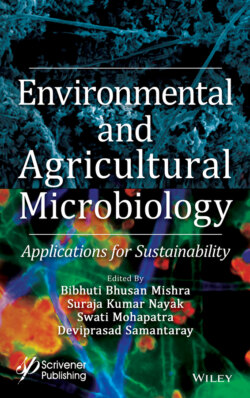Читать книгу Environmental and Agricultural Microbiology - Группа авторов - Страница 15
1.2 Pollution Due to Pesticides
ОглавлениеPesticides are anthropogenic compounds developed for human welfare by improving agricultural productivity. The estimated loss of agricultural products is 40% worldwide due to the effect of various agents such as plant diseases, pests, and weeds. Accordingly, the utilization of pesticide in agriculture has counteracted increment in this rate [6]. This is a roundabout way lessens the likelihood of price rise due to the decline in food production as a consequence of low agricultural productivity.
In addition to crop protection, pesticides also contribute to human health improvement by killing insect and rodent vectors responsible for spreading diseases. Pesticide application has been found useful in controlling various diseases such as typhus, bubonic plague, encephalitis, typhoid fever, and yellow fever, which are mainly vector-borne [16, 17]. Despite these beneficial effects, pesticides have several harmful consequences which outshadow its beneficial impacts.
Depending on solubility, pesticides can get entry into the ecosystem mainly by two processes: firstly, pesticides which are water soluble directly enter the water bodies such as ponds, rivers, lakes, and streams by getting dissolved in water and thereby adversely affecting the non-target life forms. Secondly, fat soluble pesticides get dissolved in the tissues of animals and move from one trophic level to the next through the food chain. The concentration of the pesticides in each trophic level increases as it passes from one trophic level to the other by the process of bio-amplification [18] (Figure 1.1).
Pesticides drifting from land into various water bodies such as rivers and lakes adversely affect the aquatic ecosystem. Aquatic plants are an important component of the aquatic ecosystem and are responsible for providing approximately 80% of the dissolved oxygen [6]. Death of plants due to pesticides (e.g., herbicide) can lower the level of O2 and aquatic organisms such as fishes can suffer due to oxygen depletion. This may further result in a reduction in fish productivity [19]. In addition to fishes, amphibian species are also affected by pesticide exposure. For instance, Rohr et al. [20] demonstrated a toxic impact of herbicide atrazine on some fish and amphibian species. Their mesocosm study revealed a relationship between exposure of herbicide atrazine and abundance alteration of larval trematodes in northern leopard frogs.
In addition to the aquatic ecosystem, terrestrial ecosystems are also adversely affected by the uncontrolled use of pesticide. Both target and non-target plants are affected by pesticide application. For instance, disease susceptibility of plants can be accelerated due to the application of herbicide glyphosate [21]. Further, the yield of non-targeted crops can be adversely affected by herbicides; sulphonamides, sulfonylureas, and imidazolinones [22]. Excessive use of pesticides also has deleterious effects on beneficial microbes present in the soil. Many soil dwelling microbes are involved in atmospheric nitrogen fixation. Pesticide can have a dangerous impact on these microbial communities. For example, growth and activity of soil dwelling bacteria can be negatively influenced by glyphosate [23]. Furthermore, nitrification and denitrification processes can be drastically altered by chlorothalonil and dinitrophenyl fungicides [24] (Figure 1.2).
Figure 1.1 A diagrammatic representation of pesticide bioamplification in the environment [45].
Figure 1.2 A diagrammatic representation of fate of pesticide in the environment [35].
Although pesticides contribute to the improvement of human health by controlling disease causing vectors (as mentioned earlier), it has several adverse effects as well. World Health Organization (WHO) states that about 30 lakhs cases of pesticide poisoning and 2 lakhs 20 thousand cases of death is reported annually in developing countries [25, 29]. In addition, 22 lakhs people are in danger of adverse pesticide impact in these nations [26]. Pesticides invade living system by three major routes: ingestion, inhalation, and dermal penetration [27]. Inspite of body’s capacity to degrade and excrete pesticides, some residues may occur in the system due to absorption by the blood [28]. This may result in both acute and chronic adverse effects in humans. Infants, children, pesticide applicators, and those working in agricultural farms are considered to the main victims of the adverse impact of pesticides [29].
